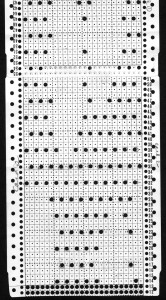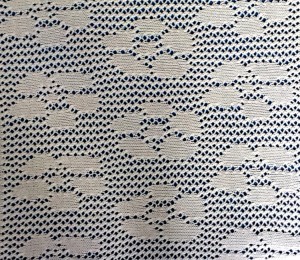Many articles were written in the 1980s in Australia, New Zealand, and Britain, some finding their way to newsletters published in the USA at the time investigating this subject. With the advent of electronics the process became “easier”. Kathleen Kinder author of several books on Machine Knitting covering myriad topics (one whole text on lace), also authored Electonic Knitting: an Introduction for Brother and Knitmaster Knitters (?1989) that investigated the move from punchcard to electronics, including lace techniques that in the instance of “filet look alikes” introduced superimposing designs as a quicker method to achieve such fabrics. The common motifs used were often that of a heart or a rose.
One of the many confusing things in lace, is that the punched holes or mylar squares do not represent actual holes in the final fabric. Alternate rows of holes represent first transfers to left, then transfer to right. Brother and Studio punchcard sets included with purchase of machines both include pre-punched cards suitable for this type of mesh. Numbers sometimes varied with machine model year. Studio No. L-6, Brother No 17J (also 20G etc.) are 2 such samples and are vertical mirrored images of each other. Superimposed motifs constitute blank areas of card. Depending on preference some readjustments may be required after a test swatch to alter placement of some of the mesh holes. My fabric below was knit using the basic faggot lace Brother mesh, the corresponding “card” close to 180 rows in length to achieve the brick repeat.
a portion of the card
sideways view of resulting fabric, knit side facing

